![]()
![]()
![]()
Use LEFT and RIGHT arrow keys to navigate between flashcards;
Use UP and DOWN arrow keys to flip the card;
H to show hint;
A reads text to speech;
28 Cards in this Set
- Front
- Back
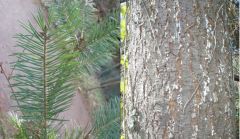
|
Douglas Fir (native) Pseudotsuga menzisii, Pinaceae - 70m tall - Branches: spread/drooping - Bark: thick ridged dark brown - Needles: Flat, yellow green, pointed tip(2-3cm) - Top of needle: 1 groove - Bottom of needle: 2 white bands of stomata - in thick canopies - only have branches on upperpart |
|
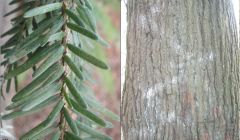
|
Western Hemlock (native) Tsuga heterophylla, Pinaceae - 60m tall - Branch: narrow crown and drooping top branch)- downward sweeping branches with feathery foliage (strong against shade) - Bark: rough and grooved but not as thick as Douglas fir - Needles: short, flat, irregular in length - TOP: yellow green - BOTTOM: 2 fine white line
|
|
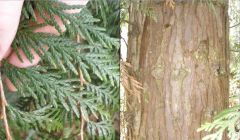
|
Western Redcedar (native) Thuja plicata, Cypress - 60m tall - Branch: droop in J shape - Bark: grey to reddish brown with fibrous strips tearing off - Leaves: awl shaped scales (braidlike) |
|
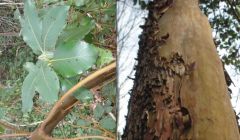
|
Madrone (native) arbutus Menziessi - small/Medium sized broad leafed evergreen - upto 30m tall - Bark: thin peeling, rich brownish red color (smooth trunk) - Leaf: alternate, oval, 15cm long - TOP : shiny green - BOTTOM: pale whitish green - Grows in dry areas (ridge/cliffs) |
|

|
Pine Trees - Pinaceae - Needles: clusters (2-5 long needles per cluster) - Bark: Scaely |
|

|
Sitka Spruce - Picea sitchensis - Large trees (70m) - Bark: thin, reddish brown into small scales (breaks up) - Needles: stiff, sharp, 4 sided - really hurts if you grab the branch |
|
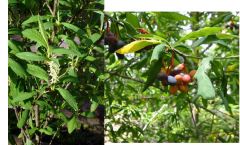
|
Indian Plum (native)- Oemlaria cerasiformis - Leaf: bright green, elongated ovals with smooth edges - small warts on bark and flowers in Febuary |
|
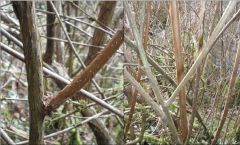
|
Salmon Berry (native)- Rubus spectabilis, Rosaceae - Forms dense thickets (4m) - deciduous - Bark: shredding on larger branches - some have golden brown thorns - Found in wet places (valley floors/streams) |
|
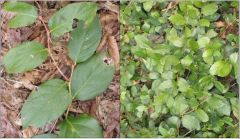
|
Salal (native) - Gaultheria shallon, Ericaceae - can form creeping ground cover - or grow erect (0.5 -5m tall) - alternate, leathery ever green leaves 5-10cm long, sharply and finely toothed edges |
|
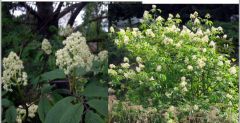
|
Red elderberry (native) - Sambucus racemosa - a shrub with attractive white, fist shape flower clusters (followed by clusters of bright red berries) - compound leaves with 5-7 branching leaflets |
|
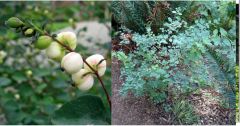
|
Snow berry (native)- Symphoricapos albus - A shrub with a scattered leaf pattern - also small clusters of pink flowers in spring -Egg white berries appear in late summer (lasts on plant through winter) |
|

|
Tall Oregon Grape (native)- Mahonia aquifolium, Berberidaceae - similar to dull oregon grape - only 5-9 leaflets - 1-2 m tall - leaf: only 1 central vein
|
|
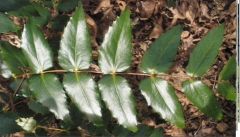
|
Dull Oregon Grape (native) - Mahonia Nervosa , Berberideceae - Low dense, evergreen - never more than 1m tall - Opposite leaf arrangement (9-19 leaflets) - leaf = not as sharp as holley - 3 central veins |
|
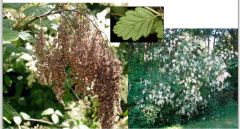
|
Ocean Spray (native) Holodiscus discolor, Rosaceae - shrub - 6-8 feet tall (taller along coasts) - Flowers turn brown in fall (lasts on plant through winter)
|
|
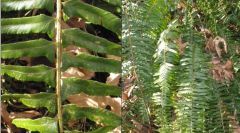
|
Sword Fern (native)- Polystichum munitum, Dryopteridaceae - Large evergreen Fern - up to 1.5 m tall - Leaf: lance shaped, alternating leaflets - most common fern in Seattle |
|
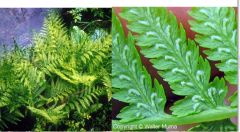
|
Lady Fern (native)- Athyrium filix- Femina - Fern - Large feathery species - abundant in shady woodland environments - Sori = shaped like commas |
|
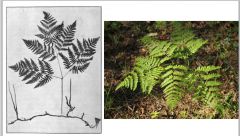
|
Bracken Fern (native)- Pteridium aquilinum - Fern - Large coarse species - found in moist woodland environments - Leaf: forms flat umbrella |
|
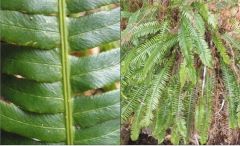
|
Deer Fern (native)- Blechnum, Blechnaceae - smaller than sword fern - evergreen - found in moist to wet places - leaflets fused directly to step (no petiole) |
|
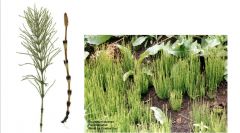
|
Horse Tail (native)- Equisteum arvense - Hightly distinctive upright, hollow, jointed, cynlindrical stems |
|
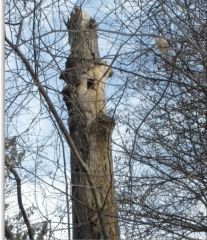
|
Snag - dead tree that is still standing - downed wood = if it falls over
be careful not to confuse snags with deciduous trees. Snags have usually lost most of their branches and bark peels off the trunk easily |
|
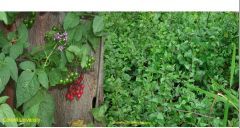
|
Bitternsweet Nightshade (invasive)- Solanum dulcamara - vine/sprawling shrub - lower stem: woody - upper branches: herbaceous ... die back every year - Leaf: dark green - Purplish (often with 1-2 small ear like lobes near base = 1-4" long) |
|
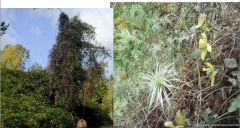
|
Clematis Traveler's Joy (invasive)- Clematis orientalis - Deciduous vine - grow as climber/scrambling shrub that attaches itself by way of tendril like stems - Flowers: have 4 yellow/greenish yellow sepals (1"long) - Easily identified in winter (white puffy seed heads sprawled over trees and shrubs) |
|
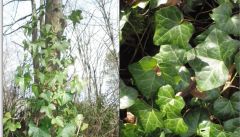
|
English Ivy (invasive) - Evergreen climbing vine - can form short dense blanket covering forest floor - leafs: 3-5 lobed - can climb up and choke trees |
|
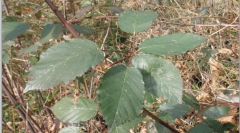
|
Himalayan Blackberry (invasive) - Erect or sprawling to form impenetrable thickets - Stem: arching, armed with stout sharp spines - Leaf: 5 leaflets, evergreen. Green-Purple above, whitish hairs underneath |
|

|
English Holly- (invasive) - Large, dense, slow growing tree/shrub - 15-50 ft tall, 15ft wide - leaf: thick, glossy, dark green and wavy (1-3 " long), alternate and simple - usually have stout spines along edges (smooth on older branches) |
|
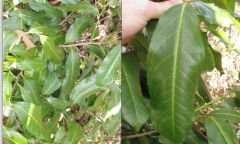
|
English Laurel (invasive) - Tall dense, spreading thicket forming shrub/small tree - 30 ft tall - grows either a single trunk tree or multi stemmed shrub - Leaf: evergreen = dark on top, pale underneath = thick and shiny, large (3-8 " long) oblong, abruptly pointed by tips - alternate on steps - finely toothed edges/short leaf stalks |
|
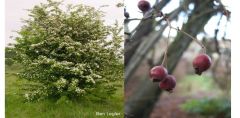
|
English Hawthon (invasive) - Crategus monogyna - Thorny, deciduous small tree - 6- 30ft tall - leaf: resembling mitten/paw -fruit: round/crimson berry (often persists to late winter) |
|
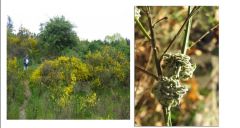
|
Scotch Broom (invasive)- Cytisus scoparius - perennial, leguminous shrub native to western/central Europe introduced for ornamental and erosion control - Branching: loose with green, slender ribbed branches - Leaf: simple - growing primarily in open, dry meadows and along road sides |

